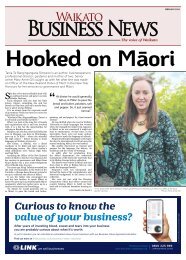Waikato Business News July/August 2023
Waikato Business News has for a quarter of a century been the voice of the region’s business community, a business community with a very real commitment to innovation and an ethos of cooperation.
Waikato Business News has for a quarter of a century been the voice of the region’s business community, a business community with a very real commitment to innovation and an ethos of cooperation.
You also want an ePaper? Increase the reach of your titles
YUMPU automatically turns print PDFs into web optimized ePapers that Google loves.
14 WAIKATO BUSINESS NEWS, JULY/AUGUST <strong>2023</strong><br />
Noughts and crosses - is the property<br />
market swinging from over to under-supply?<br />
I seem to love talking about circles<br />
and cycles, but this month’s column<br />
is centred around the opposite - the<br />
cross-shaped graph of supply and<br />
demand, with equilibrium sitting<br />
smack in the centre.<br />
It’s a simple economic<br />
concept, and it’s one that’s<br />
become synonymous with<br />
the property market in recent<br />
years. Kiwis flooded home<br />
during and immediately after<br />
the height of the COVID-19<br />
pandemic, which impacted the<br />
demand for housing here in<br />
New Zealand and caused house<br />
prices to increase at unprecedented<br />
rates.<br />
But what’s interesting about<br />
this is how quickly the pendulum<br />
is swinging back, and<br />
how “lower supply and higher<br />
demand” is now starting to<br />
affect how property is priced.<br />
For the first time in nearly<br />
two years I heard an agent<br />
this week say, “we haven’t got<br />
enough properties to sell”,<br />
and this characteristic is being<br />
driven by a few factors I find<br />
quite interesting.<br />
Economic commentators<br />
and even the RBNZ have<br />
started rhetoric that the bottom<br />
of the property market<br />
has been and gone this cycle,<br />
and this is starting to spread<br />
its tendrils out into the mainstream<br />
media. A self-fulfilling<br />
prophecy is encouraging more<br />
people to take action and bank<br />
some early equity as prices look<br />
ready to rebound back to equilibrium<br />
and beyond.<br />
There is no doubt that the<br />
Government’s efforts to bring<br />
more skilled workers into the<br />
country have resulted in a shortage<br />
of housing. In response,<br />
there are more agents reporting<br />
multi-offers on properties, particularly<br />
in the bottom to middle<br />
of the market where buyers<br />
don’t need to sell a property<br />
to make their purchase work,<br />
and offshore cash is making its<br />
way into the housing market to<br />
allow new immigrants to set up<br />
a new life in New Zealand.<br />
We’re hearing more and<br />
BEYOND THE<br />
BANKS<br />
BY CLAIRE WILLIAMSON<br />
Claire Williamson is a mortgage<br />
advisor for My Mortgage<br />
more that first home buyers are<br />
lining up to get into the property<br />
market. This follows changes in<br />
June that have made it a bit easier<br />
to purchase properties with<br />
lower deposits, as well as some<br />
lesser-known changes to the<br />
First Home Partner scheme,<br />
where Kainga Ora is supporting<br />
more buyers with equity deposits<br />
and extending these to existing<br />
properties rather than just<br />
new builds.<br />
This is more pronounced<br />
than it was in previous months<br />
as the effect of a swing towards<br />
a slight shortage of properties<br />
heading into a traditionally<br />
busy time of the year is causing<br />
competition in the mid-range<br />
valued properties. More buyers<br />
are finding themselves needing<br />
to get their ducks in a row so<br />
they’re in with a chance.<br />
In <strong>August</strong> the Reserve Bank<br />
kept the OCR on hold, but<br />
interestingly also signalled that<br />
they wouldn’t hesitate to hold<br />
rates up at the current level for<br />
an extended period, which is<br />
likely to preclude a rate drop<br />
before the middle of 2024,<br />
and even another small rise<br />
if needed.<br />
Fixed rates have remained<br />
largely unchanged, albeit a few<br />
banks are discounting rates<br />
for strong clients. Relatively<br />
short terms continue to be solid<br />
options for many borrowers,<br />
but it’s worth considering the<br />
level of risk you’re willing to<br />
take in a still-uncertain rate<br />
market where they may remain<br />
higher for longer, and there is<br />
a fractional move towards 18<br />
months to two-year periods.<br />
An uptick in demand is<br />
underpinned by some uncertainty.<br />
The political race is<br />
on with only six weeks till an<br />
all-important general election,<br />
where perceived Government<br />
overspending, inflation, cost<br />
of living and interest rate hikes<br />
have all been big conversations<br />
amongst political leaders.<br />
Investors and speculative<br />
developers have stepped back<br />
for the past few years as affordability<br />
has tightened, and given<br />
the high demand for rental<br />
housing, they are ready to<br />
re-enter the market if interest<br />
deductibility is reinstated.<br />
So - how do we win this<br />
game of noughts and crosses?<br />
Beware, beware how you compare…<br />
Capturing the consumer<br />
dollar can be a challenge<br />
at the best<br />
of times.<br />
At the worst of times, such<br />
as arguably those New Zealand<br />
is experiencing at the moment,<br />
it can be even harder.<br />
It is not surprising then<br />
that to maximise their chances<br />
of capturing the dollar, businesses<br />
might undertake what<br />
in legal speak is called comparative<br />
advertising. That is,<br />
advertising in which either a<br />
business states that its products<br />
(usually) are compatible<br />
with another brand’s products,<br />
or a business compares<br />
its goods (or services) to the<br />
goods (or services) of one or<br />
more competitors, highlighting<br />
the benefits of that business’s<br />
goods over the competitors’.<br />
The benefits might be<br />
lower price, greater value, better<br />
performance or durability,<br />
for example.<br />
Done right, comparative<br />
advertising can be very successful,<br />
achieving brand switch<br />
and long-term loyalty. Just ask<br />
Whittaker’s and potentially<br />
Pak’nSave (Kiwis will know<br />
what I mean here…).<br />
Done wrong, and you can<br />
infringe registered trade mark<br />
rights (if you use a competitor’s<br />
trading name or logo in<br />
your ad) and/or breach New<br />
INTELLECTUAL<br />
PROPERTY ISSUES<br />
BY BEN CAIN<br />
Ben Cain is a Senior Associate<br />
at James & Wells and a<br />
Resolution Institute-accredited<br />
mediator. He can be contacted<br />
at 07 957 5660 (Hamilton),<br />
07 928 4470 (Tauranga) and<br />
benc@jaws.co.nz.<br />
Zealand’s Fair Trading Act<br />
1986 and Advertising Standards<br />
Code.<br />
A well-publicised recent<br />
example of where a business<br />
‘got it wrong’ in New Zealand<br />
involves the kiwi toy company,<br />
Zuru 1 , and the world famous<br />
brickmaker, Lego 2 . Zuru had<br />
used the LEGO word mark on<br />
packaging for its own ‘MAX<br />
Build More’ toy bricks to<br />
advertise they were compatible<br />
with Lego branded bricks.<br />
Lego had not consented to<br />
Zuru’s use and, to cut a long<br />
legal story short, sued Zuru<br />
for trade mark infringement,<br />
passing off and breach of the<br />
Fair Trading Act.<br />
Although it failed on its<br />
passing off and Fair Trading<br />
Act claims, Lego did succeed<br />
on its trade mark infringement<br />
claim on the grounds Zuru did<br />
not use the LEGO trade mark<br />
in accordance with honest<br />
practices in commercial matters<br />
and its use took unfair<br />
advantage of the LEGO trade<br />
mark. Further, it was not reasonably<br />
necessary for Zuru to<br />
use the LEGO trade mark in<br />
such a prominent way on the<br />
front panels of its containers<br />
and packaging to indicate<br />
either a characteristic of its<br />
products or the intended purpose<br />
of its products.<br />
Outside the world of toy<br />
bricks, I am aware of two<br />
other recent examples where<br />
competitors have undertaken<br />
questionable comparative<br />
advertising. Due to client confidentiality,<br />
I am unable to<br />
divulge further details. It suffices<br />
to say however that when<br />
scrutinised, the comparisons<br />
– which involved comparisons<br />
of product features – did not<br />
stack up: quite the opposite,<br />
the comparisons were fundamentally<br />
flawed and, should<br />
they have been tested in a<br />
court, would, I venture, been<br />
found so.<br />
There are, I perceive, four<br />
key ‘rules’ when it comes to<br />
comparative advertising:<br />
1. If making compatibility<br />
statements, like Zuru, ask<br />
yourself (and sense check<br />
with others) whether using<br />
your competitor’s name or<br />
logo is really necessary. A<br />
good rule of thumb might<br />
be, ‘If in doubt, leave it out’.<br />
2. If comparing goods or<br />
services, compare apples<br />
with apples, not apples<br />
with pears and, worse still,<br />
lemons;<br />
3. If you are questioned, make<br />
sure you can wholly justify<br />
the claims you make in<br />
your advertising; and<br />
4. If you are in any doubt, seek<br />
appropriate legal advice.<br />
Forewarned is forearmed.<br />
1. Zuru New Zealand Limited<br />
and Zuru Toys New Zealand<br />
Limited, to be precise.<br />
2. Lego Juris A/S and Lego<br />
A/S, to be precise.

















